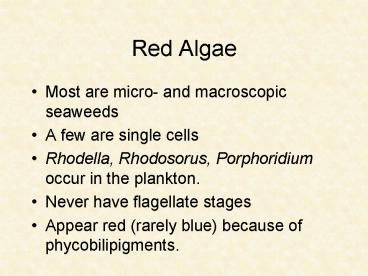Red Algae - PowerPoint PPT Presentation
1 / 64
Title:
Red Algae
Description:
Rhodella, Rhodosorus, Porphoridium occur in the plankton. Never have flagellate stages ... tide pools, near or on substrate (rarely in plankton) Tetreutreptia ... – PowerPoint PPT presentation
Number of Views:176
Avg rating:3.0/5.0
Title: Red Algae
1
Red Algae
- Most are micro- and macroscopic seaweeds
- A few are single cells
- Rhodella, Rhodosorus, Porphoridium occur in the
plankton. - Never have flagellate stages
- Appear red (rarely blue) because of
phycobilipigments.
2
Rhodosorus
3
Rhodella
4
Green Algae
- Numerous classes of green algae
- Two major lineages to land plants, not to land
plants - Usually two equal anterior flagella
- Swimming is usually by breast stroke
- Most have no light-harvesting pigments other than
chlorophylls a and b, so they appear green.
5
Tetraselmis
6
Pyramimonas
7
Dunaliella
8
Pterosperma
9
Asteromonas
10
Prasinococcus
11
Mesostigma
12
Haptophytes - Prymnesiophytes
- Golden brown color because of carotenoids
- Two /- equal flagella, no hairs
- Swim two ways
- flagella pull cell with breast stroke
- flagella push cell with weak sinusoidal beat
- Two chloroplasts
- Some produce coccoliths
13
Emiliania huxleyi
14
Ochrosphaera
15
Chrysochromulina
16
Phaeocystis
17
Pavlova
18
Prymnesium
19
Blue-green algae - cyanobacteria
- Prokaryotic cells, no nucleus, no organelles
- Most with chlorophyll a only
- Prochlorococcus is putatively most abundant
organism on the planet - Synechococcus is widespread, common
- Both discovered only recently
- Some capable of nitrogen fixation
20
Prochlorococcus
21
Synechococcus
22
Trichodesmium
23
Chroococcidiopsis or Myxosarcina
24
Cylindrospermatopsis
25
Tolypothrix
26
Arthrospira
27
Anabaena
28
Euglenophytes
- Chlorophyll a and b only, so look green
- Usually with 2 anterior flagella, but
Tetreutreptia has 4 flagella - Mostly estuarian, tide pools, near or on
substrate (rarely in plankton)
29
Tetreutreptia
30
Pelagophyceae
- Common open ocean picoplankters
- Aureococcus, Aureoumbra are coastal
- Olive green color
- Various flagellar types, or no flagella
31
Aureoumbra
32
Pelagomonas
Aureococcus
33
Dictyochophyceae
- Silicoflagellates, Pedinellids, Rhizochromulina
34
Pseudopedinella
35
Rhizochromulina
36
Bolidophyceae
- Oceanic picoplankters related to diatoms
- Two flagella
- Golden color, with light-harvesting carotenoids
- Two known species only
37
Bolidomonas
38
Raphidophyceae
- Heterosigma, Chattonella are fish killers
- Mostly restricted to coastal harbors, bays
- Numerous discoid chloroplasts (golden)
- Two flagella, one anterior (with hairs), one
posterior
39
Heterosigma
40
Chattonella
41
Haramonas
42
Chlorarachniophytes
- Related to amoebae, but have chloroplasts from
endosymbiotic event - Nucleomorph is present
- Chlorophylls a and b, green in color
- One famous flagellate - Bigelowiella
43
Bigelowiella natans
44
Gymnochloris
45
Lothariella
46
Chlorarachnion
47
Cryptophytes
- 2 anterior flagella, bipartite flagellar hairs
- Red, green or blue phycobilipigments
- Nucleomorph
- Ejectosomes
- Periplast usually of organic plates
48
Campylomonas
Chroomonas
49
Proteomonas
50
Rhodomonas
51
Glaucophytes
52
Cyanophora
53
Chrysophytes
54
Dinobryon balticum
55
Dinobryon sociale
56
Poterioochromonas
57
Chrysamoeba
58
Phaeoplaca
59
Epipyxis
60
Phaeothamniophyceae
61
Phaeoschizochlamys
62
Phaeothamnion
63
Stichogloea
64
(No Transcript)































